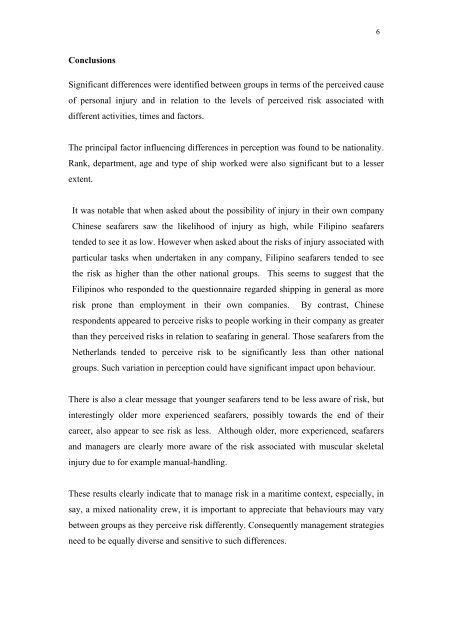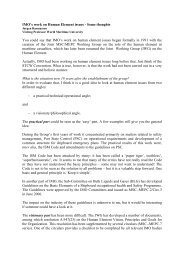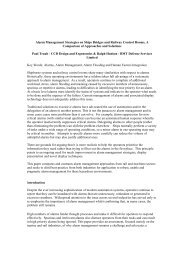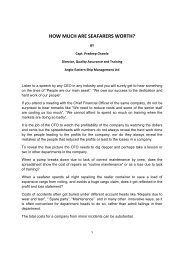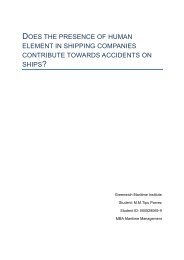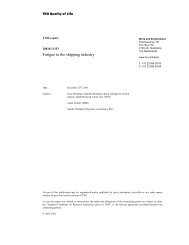Perceptions of Risk in the Maritime Industry Personal Injury
Download PDF - Alert!
Download PDF - Alert!
- No tags were found...
You also want an ePaper? Increase the reach of your titles
YUMPU automatically turns print PDFs into web optimized ePapers that Google loves.
6<br />
Conclusions<br />
Significant differences were identified between groups <strong>in</strong> terms <strong>of</strong> <strong>the</strong> perceived cause<br />
<strong>of</strong> personal <strong>in</strong>jury and <strong>in</strong> relation to <strong>the</strong> levels <strong>of</strong> perceived risk associated with<br />
different activities, times and factors.<br />
The pr<strong>in</strong>cipal factor <strong>in</strong>fluenc<strong>in</strong>g differences <strong>in</strong> perception was found to be nationality.<br />
Rank, department, age and type <strong>of</strong> ship worked were also significant but to a lesser<br />
extent.<br />
It was notable that when asked about <strong>the</strong> possibility <strong>of</strong> <strong>in</strong>jury <strong>in</strong> <strong>the</strong>ir own company<br />
Ch<strong>in</strong>ese seafarers saw <strong>the</strong> likelihood <strong>of</strong> <strong>in</strong>jury as high, while Filip<strong>in</strong>o seafarers<br />
tended to see it as low. However when asked about <strong>the</strong> risks <strong>of</strong> <strong>in</strong>jury associated with<br />
particular tasks when undertaken <strong>in</strong> any company, Filip<strong>in</strong>o seafarers tended to see<br />
<strong>the</strong> risk as higher than <strong>the</strong> o<strong>the</strong>r national groups. This seems to suggest that <strong>the</strong><br />
Filip<strong>in</strong>os who responded to <strong>the</strong> questionnaire regarded shipp<strong>in</strong>g <strong>in</strong> general as more<br />
risk prone than employment <strong>in</strong> <strong>the</strong>ir own companies. By contrast, Ch<strong>in</strong>ese<br />
respondents appeared to perceive risks to people work<strong>in</strong>g <strong>in</strong> <strong>the</strong>ir company as greater<br />
than <strong>the</strong>y perceived risks <strong>in</strong> relation to seafar<strong>in</strong>g <strong>in</strong> general. Those seafarers from <strong>the</strong><br />
Ne<strong>the</strong>rlands tended to perceive risk to be significantly less than o<strong>the</strong>r national<br />
groups. Such variation <strong>in</strong> perception could have significant impact upon behaviour.<br />
There is also a clear message that younger seafarers tend to be less aware <strong>of</strong> risk, but<br />
<strong>in</strong>terest<strong>in</strong>gly older more experienced seafarers, possibly towards <strong>the</strong> end <strong>of</strong> <strong>the</strong>ir<br />
career, also appear to see risk as less. Although older, more experienced, seafarers<br />
and managers are clearly more aware <strong>of</strong> <strong>the</strong> risk associated with muscular skeletal<br />
<strong>in</strong>jury due to for example manual-handl<strong>in</strong>g.<br />
These results clearly <strong>in</strong>dicate that to manage risk <strong>in</strong> a maritime context, especially, <strong>in</strong><br />
say, a mixed nationality crew, it is important to appreciate that behaviours may vary<br />
between groups as <strong>the</strong>y perceive risk differently. Consequently management strategies<br />
need to be equally diverse and sensitive to such differences.


